Why you can trust Tom's Hardware
Our new test PC uses an Nvidia PCAT v2 device, and we've switched from the Powenetics hardware and software we've previously used to PCAT, as it gives us far more data without the need to run separate tests. PCAT with FrameView allows us to capture power, temperature, and GPU clocks from our full gaming suite. The charts below are the geometric mean across all 15 games, though we also have full tables showing the individual results further down the page.
If you're wondering: No, PCAT does not favor Nvidia GPUs in any measurable way. We checked power with our previous setup for the same workload and compared that with the PCAT, and any differences were well within the margin of error (less than 1%). PCAT is external hardware that simply monitors the power draw of the PCIe power cables as well as the PCIe x16 slot by sitting between the PSU/motherboard and the graphics card.
We have separate charts for 1080p medium, 1080p ultra, 1440p ultra, and 4K ultra below. We'll just take them in that order for this review. We also have noise level test results further down the page.
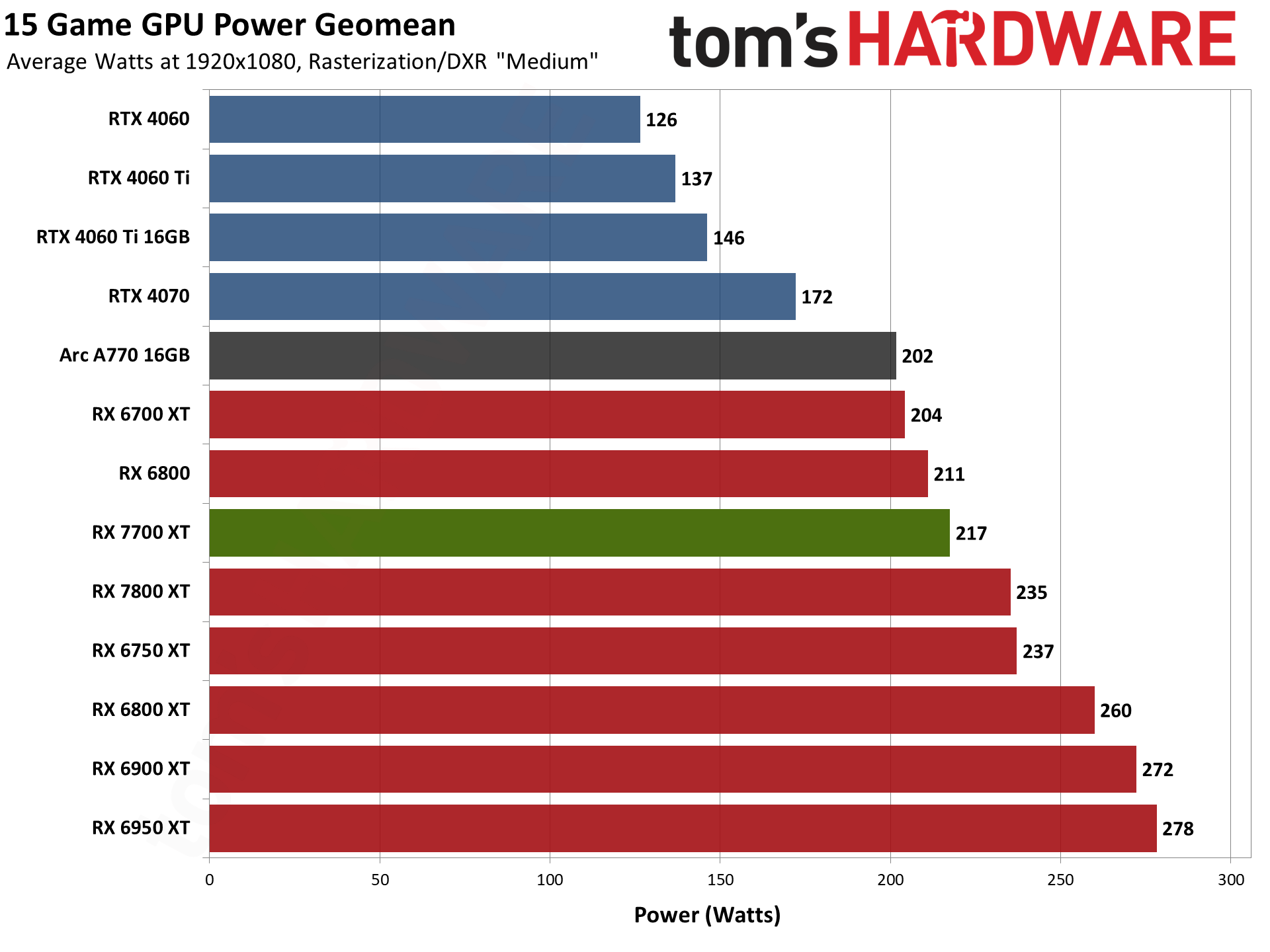

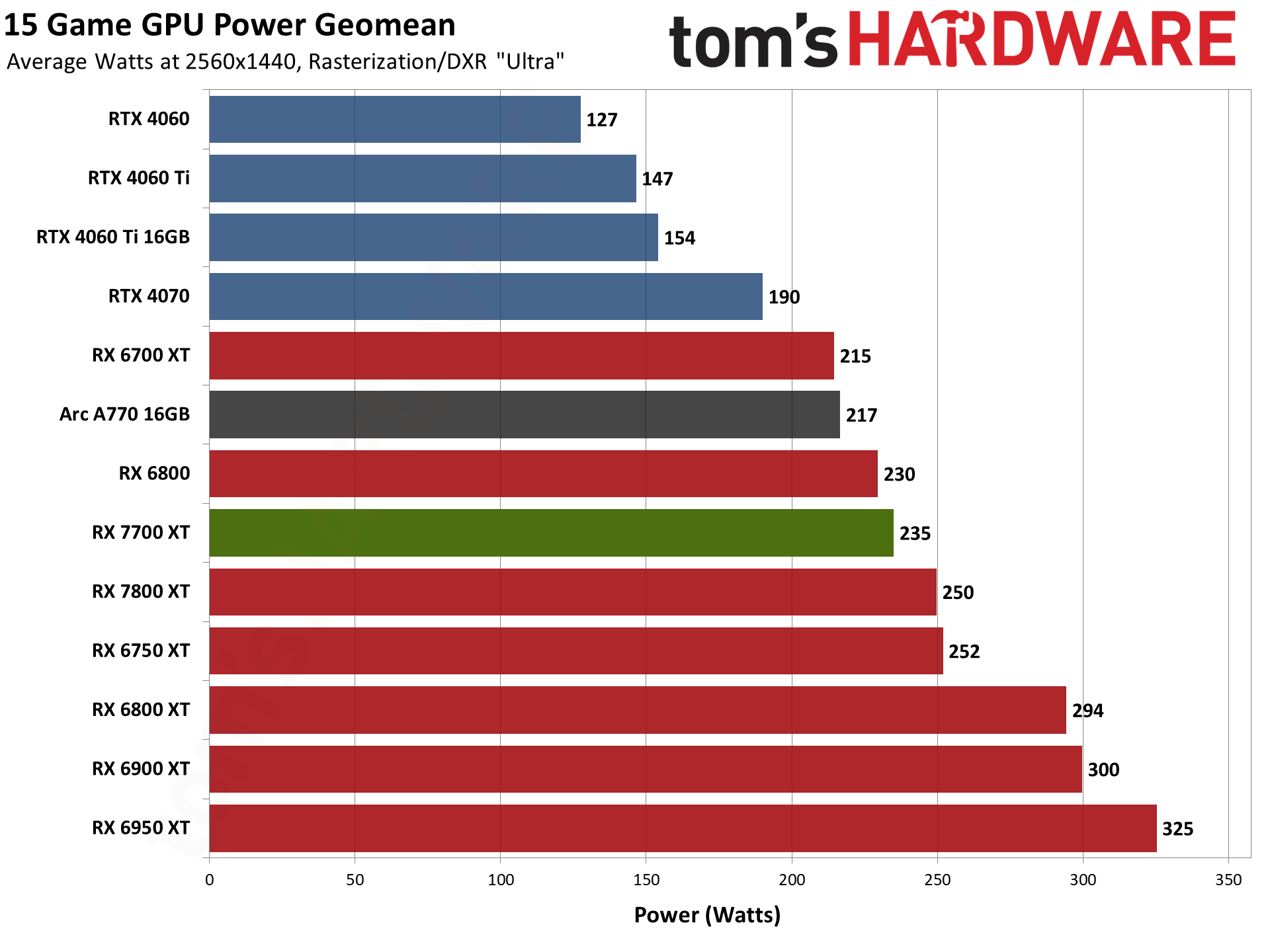

AMD's RX 7700 XT has a 245W official TBP (total board power), and in testing it averaged 218W at 1080p medium up to 239W at 4K ultra. More telling is that the similarly performing RX 6800 averaged 211W at 1080p medium up to 238W at 4K ultra. In other words, the new RX 7700 XT can't even clearly exceed the efficiency level of the previous generation RX 6800.
We have to think that a lot of the power must be going into the GPU chiplet interconnect — "a lot" being relative. With a 5nm GCD and 6nm MCDs, you'd normally expect a net improvement in efficiency, and that has generally been the case with the higher tier RX 7000-series parts. But perhaps the RX 7700 XT shows the limits of the scaling; certainly, using 93% of the TGP of the 7800 XT while delivering 85% of the performance (give or take) isn't a great result.
Nvidia's competing cards use far less power, with the RTX 4060 Ti averaging 137W to 147W across our test suite. That's about 80W less power while gaming, give or take, and AMD still has some idle power issues with certain monitors — I know, for example, that when connected to an Acer Predator X27 G-Sync monitor, the 7700 XT idles at 40W or more. As bad as that might seem, the 7900 XTX is worse, drawing 80–90 watts at idle with that particular screen. Oops.
For now, if you're trying to get optimal efficiency, Nvidia's RTX 40-series GPUs are way ahead of anything AMD offers.

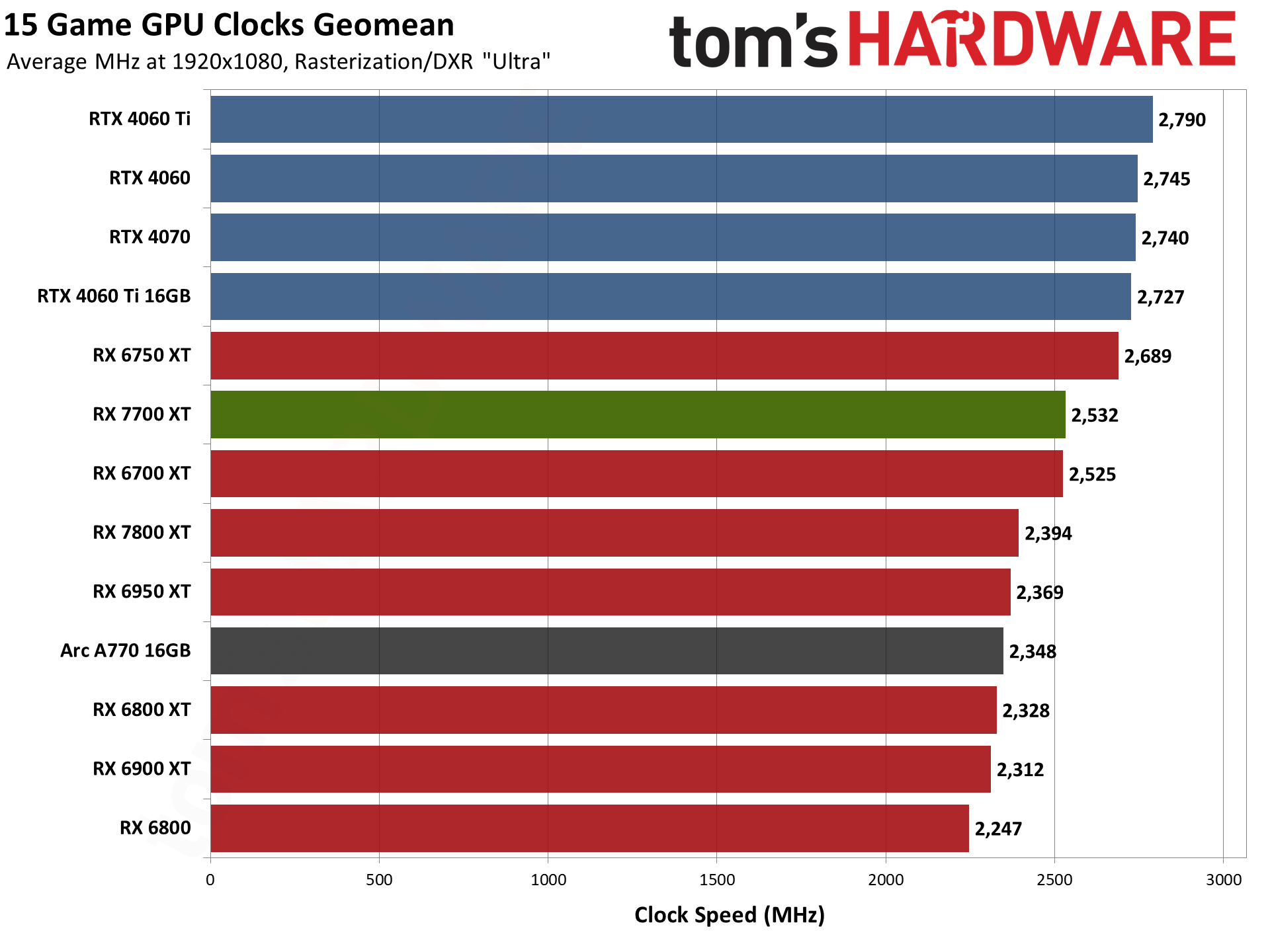
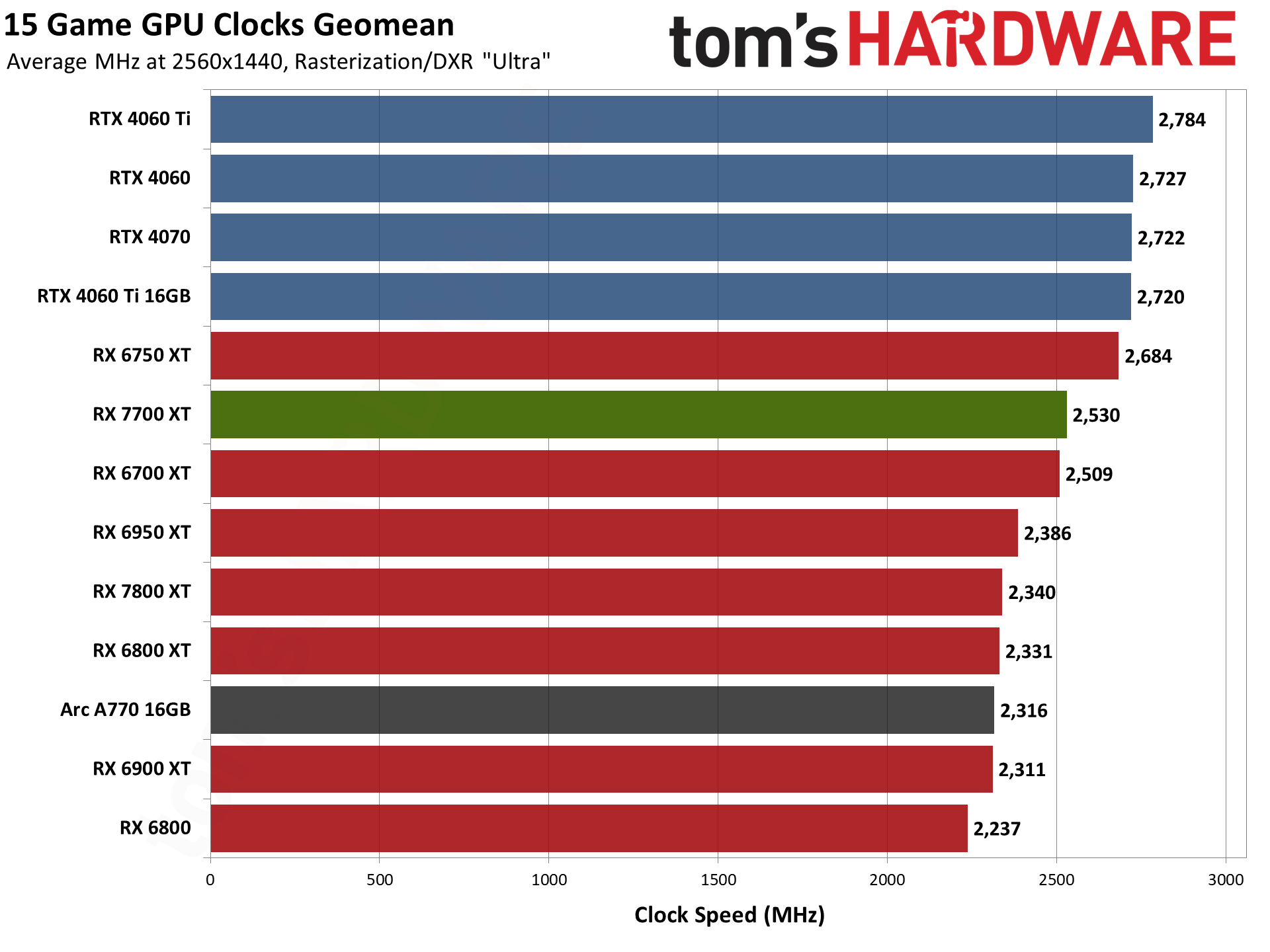
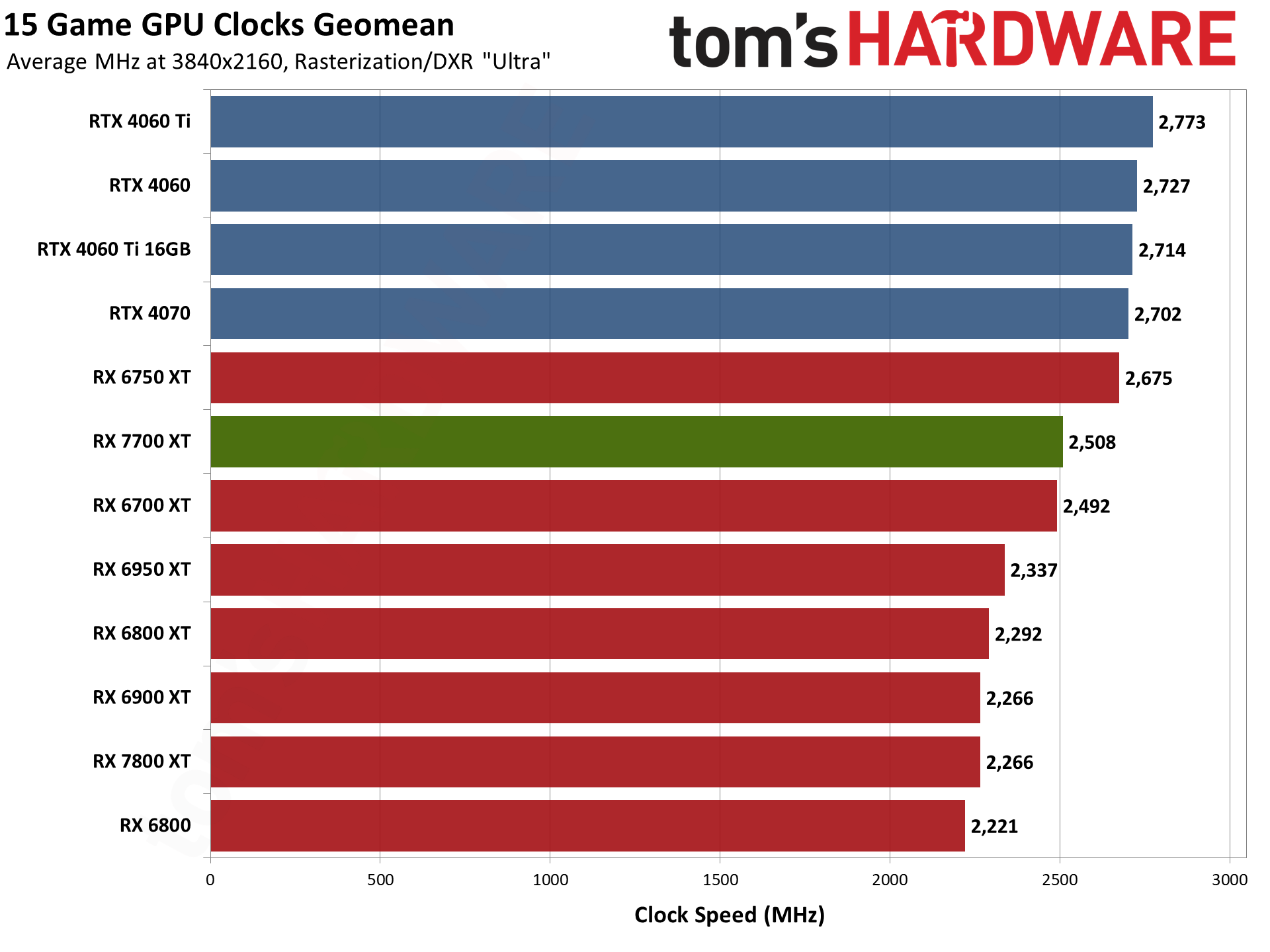
GPU clock speeds aren't extremely important, but it's interesting to see where they land. Take the RX 7700 XT, which has an official game clock of 2544 MHz. With Nvidia and Intel GPUs, you can normally expect the cards to meet or exceed the stated boost clock, but that's not always true with AMD's RDNA 3 GPUs.
The closest we got for our entire 15-game suite to that game clock was at 1080p medium, where the XFX card averaged 2538 MHz. Higher resolutions and settings dropped the average clocks a bit, with a result of 2508 MHz at 4K ultra.
You can see all of the average clocks for each game and setting tested in a table further down the page. The key takeaway is that AMD's stated Game Clock looks to be reasonably accurate but often overshoots the mark. Nvidia's stated boost clocks, meanwhile, often end up being 100–200 MHz lower than our real-world measurements.

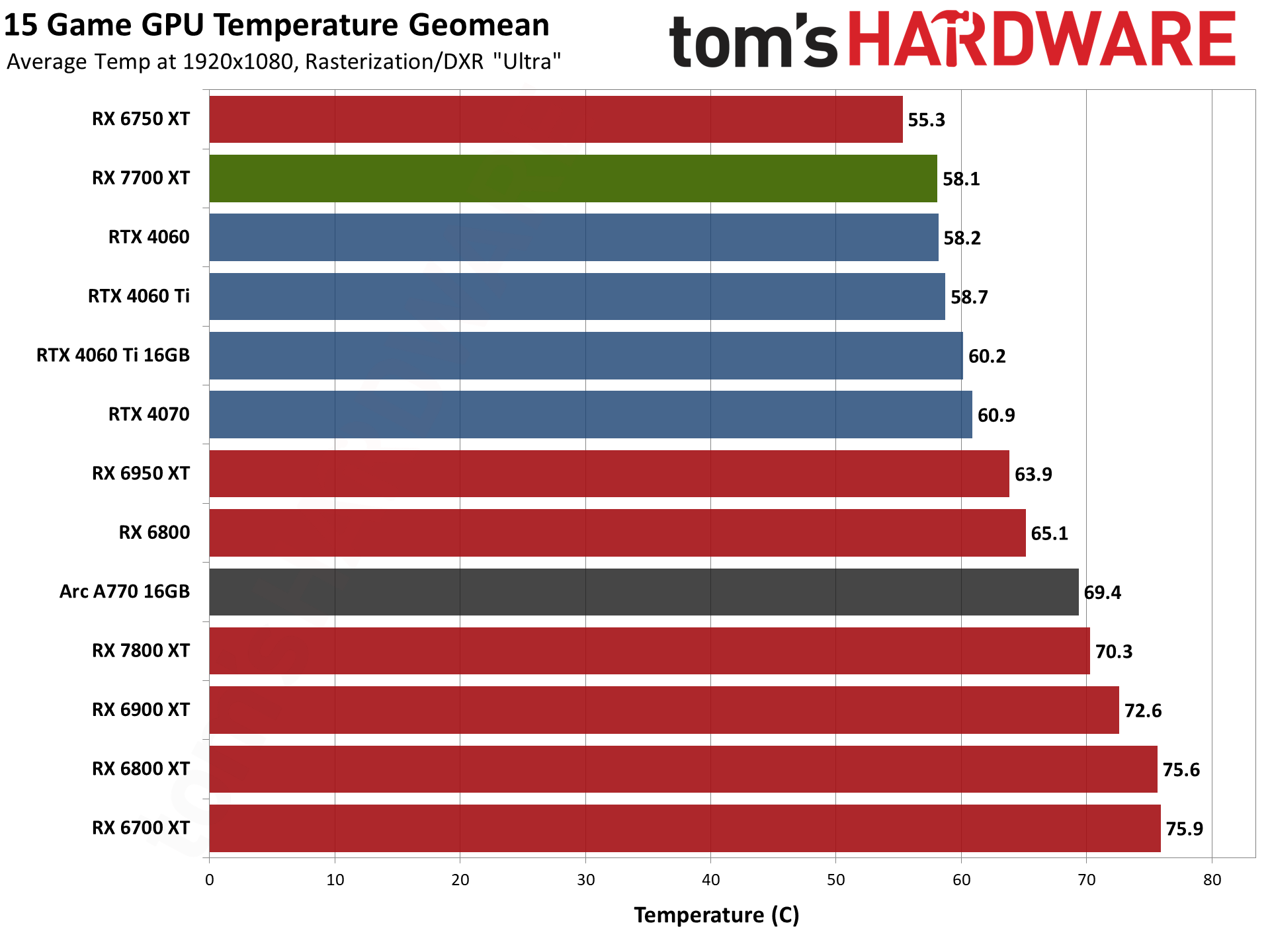

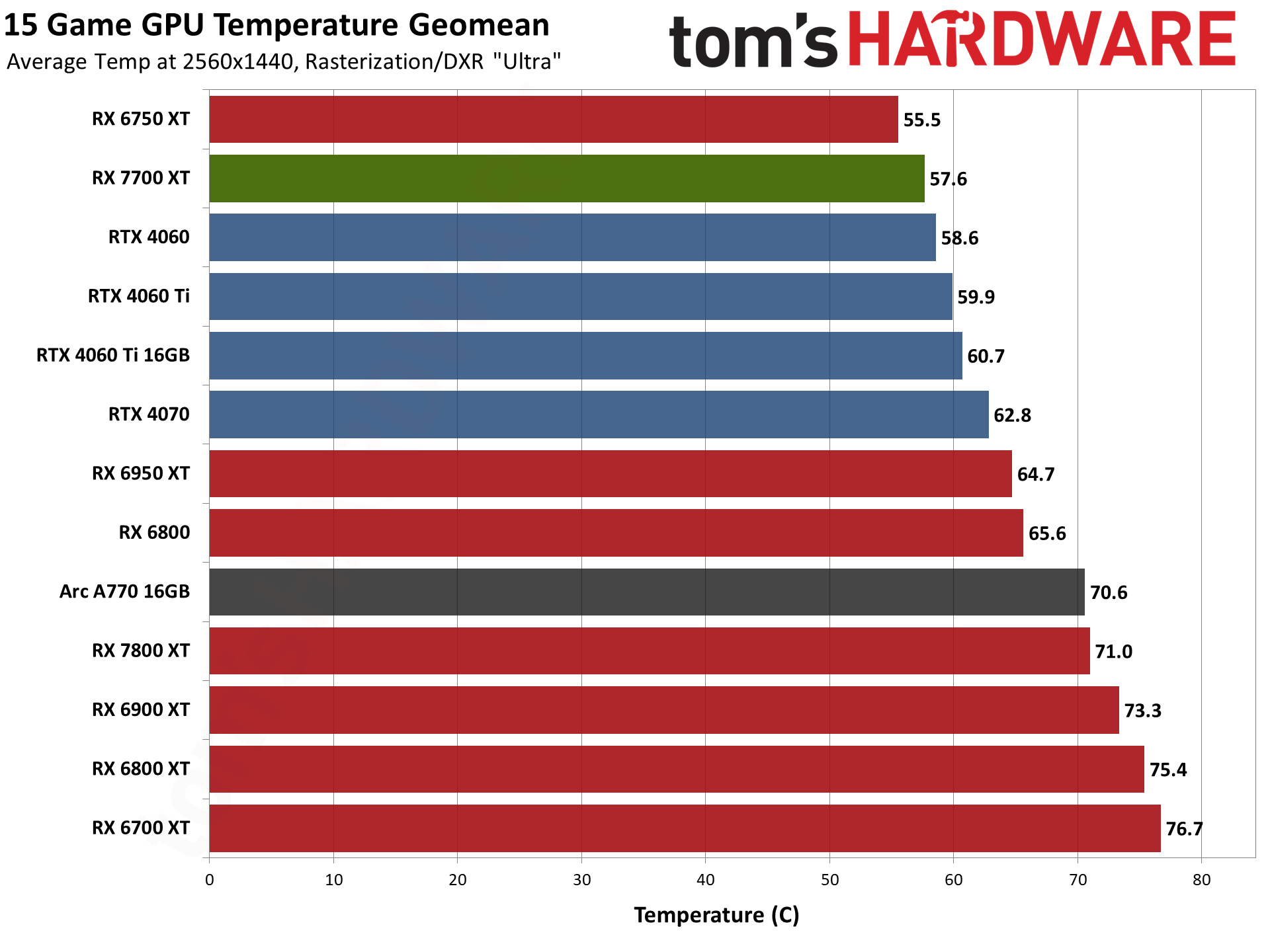
The XFX RX 7700 XT isn't what we'd call a beautiful card, but one thing it does have in ample supply is cooling potential. The peak temperature across our full test suite was 63C, and many games stayed below 60C (with an ambient temperature of around 22C).
Just as important as having low temperatures is keeping noise levels down. Triple fans combined with a large radiator should get the job down, and that's what we found with our noise testing.
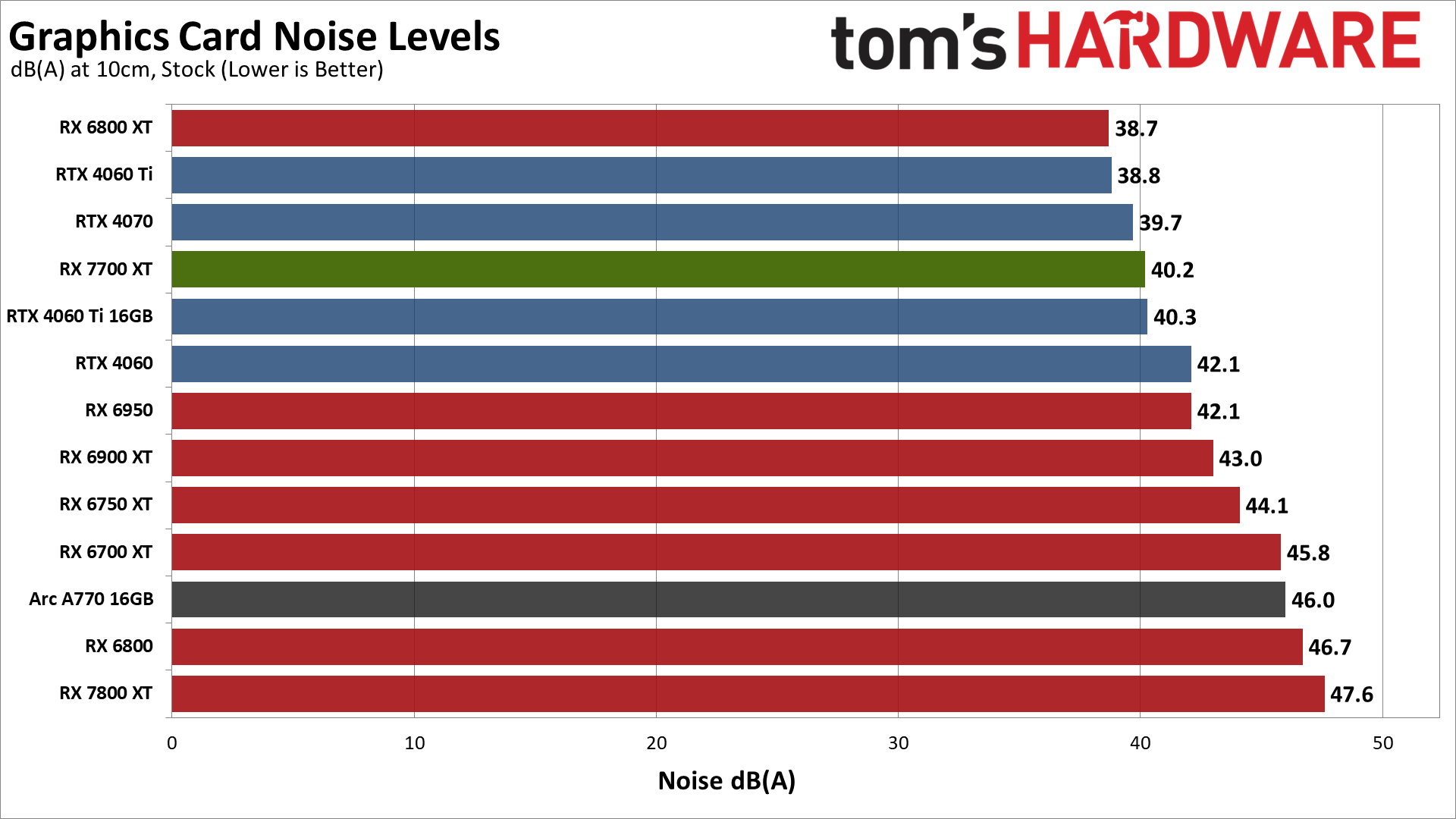
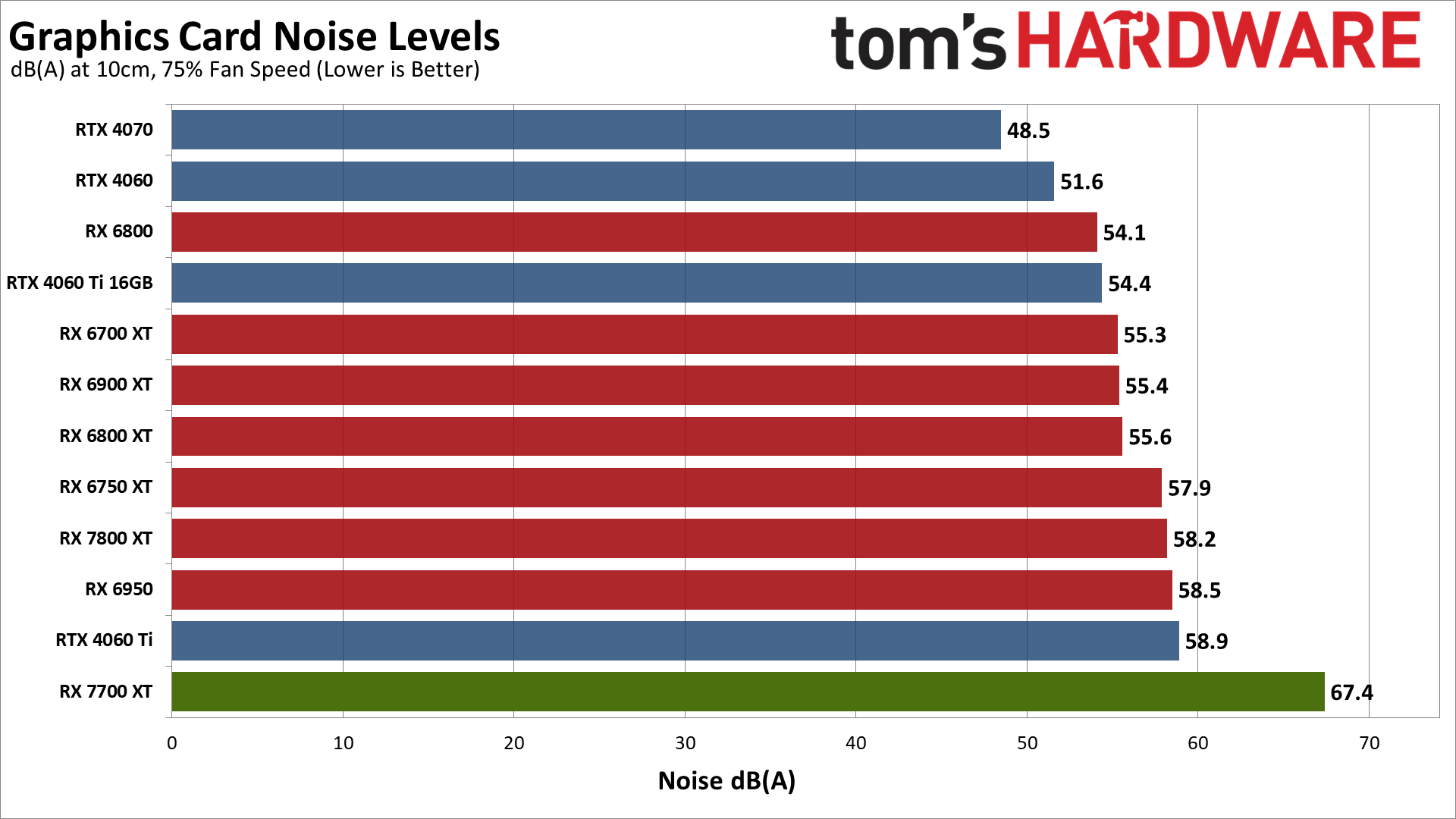
Unlike the reference RX 7800 XT, the XFX 7700 XT noise results are quite good. It's not the quietest card we've tested, but after prolonged testing it stabilized at about 40 dB(A). The fans were just barely moving, at 23% fan speed — below what you can manually set in MSI Afterburner. There are quieter GPUs, but not by much unless they opt to go fanless, which is a whole other can of worms.
For reference, our noise test consists of running Metro Exodus Enhanced, as it's one of the more power hungry games. We load a save, with graphics set to appropriately strenuous levels (1440p ultra in this case), and then let the game sit for at least 15 minutes before checking noise levels. We place the SPL (sound pressure level) meter 10cm from the card, with the mic aimed at the center of the back fan. This helps minimize the impact of other noise sources, like the fans on the CPU cooler. The noise floor of our test environment and equipment is around 31–32 dB(A).
Given the gaming tests were only pushing 23% fan speed, you can imagine there's plenty of room for more cooling if the card needs it. We also test with a static fan speed of 75%, which ratcheted up the noise level to 67.4 dB(A). That's one of the loudest results we've encountered, but you're unlike to hit such high fan speeds unless you intentionally mess with the fan curves.
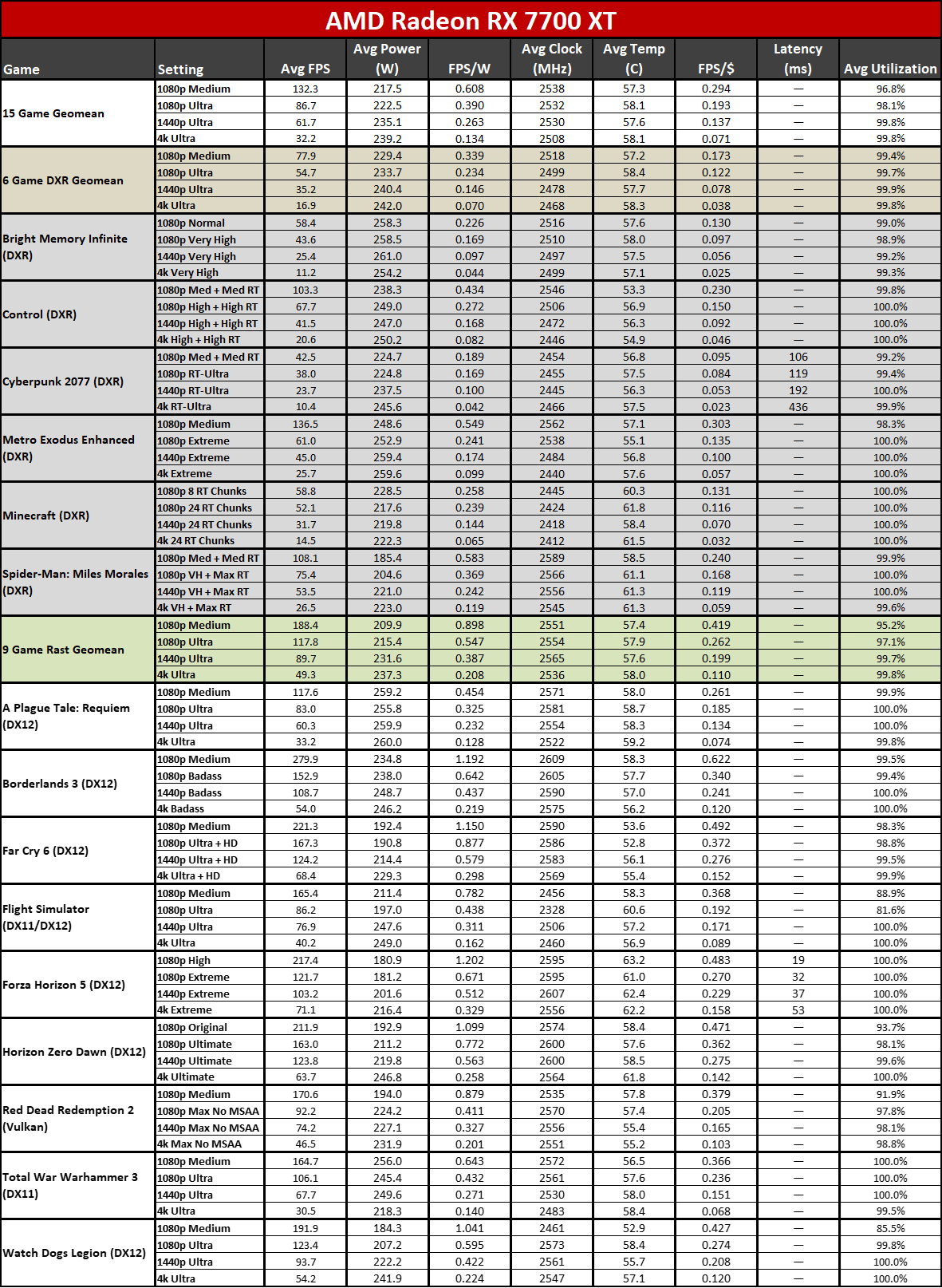
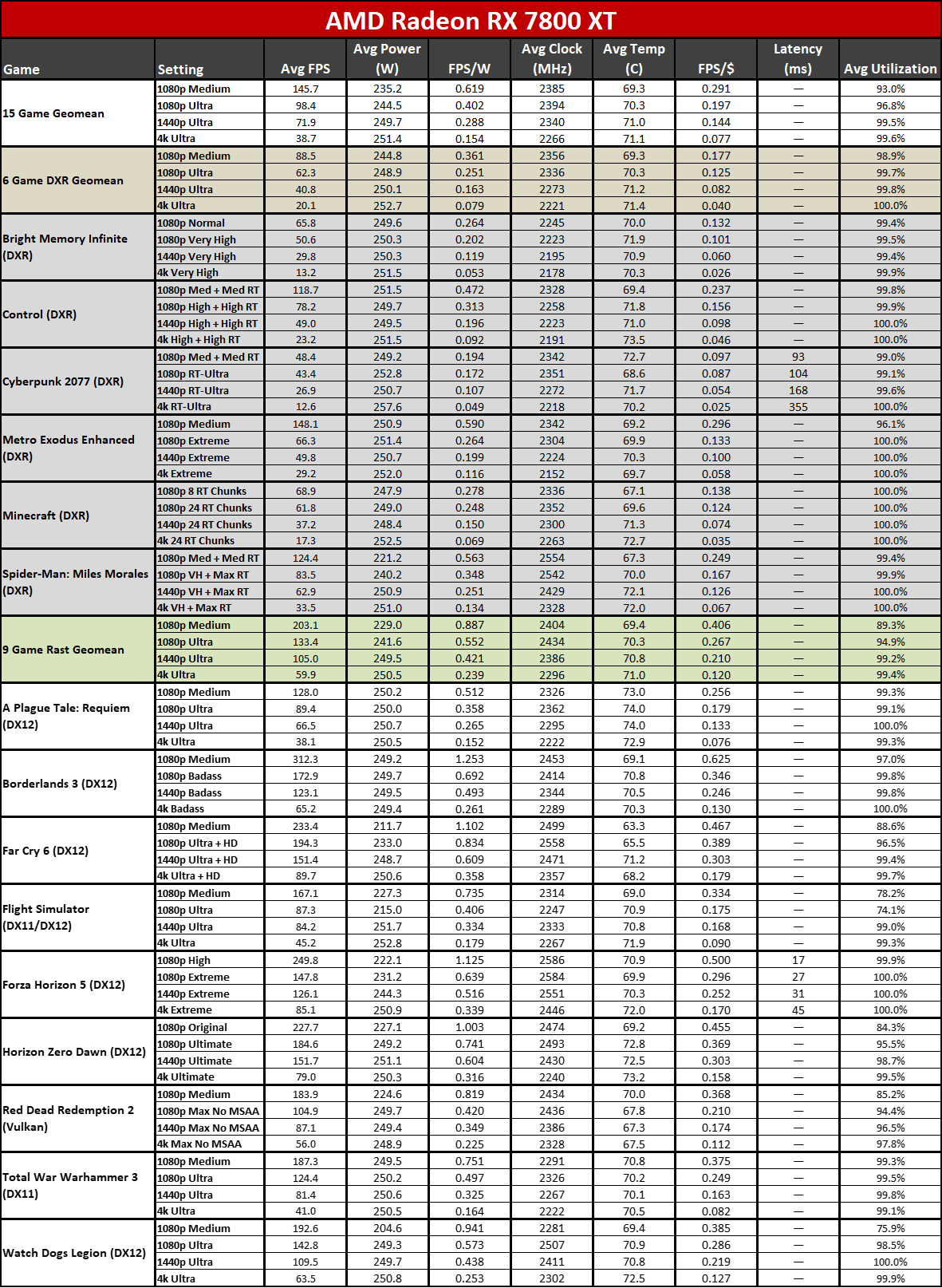

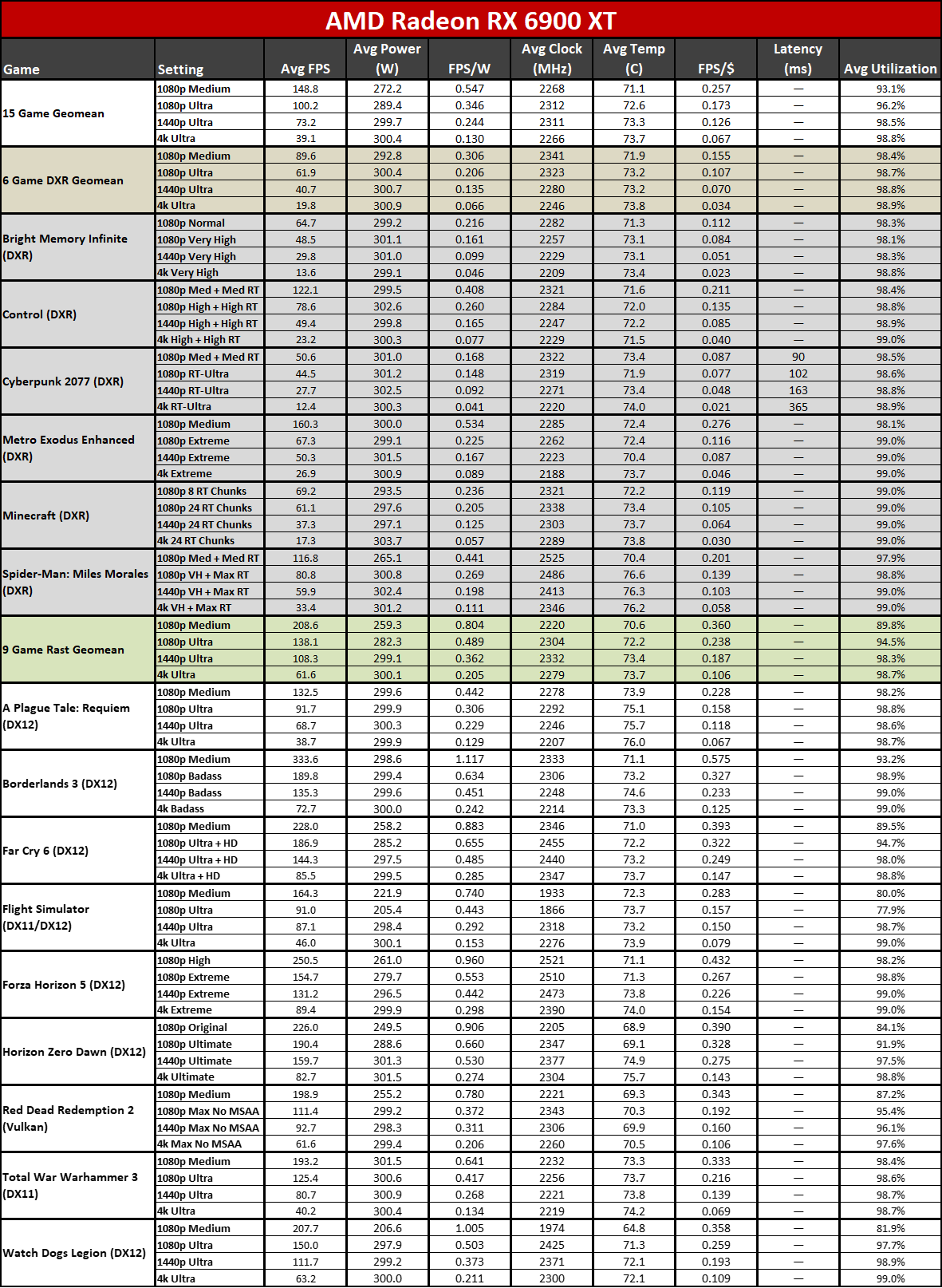


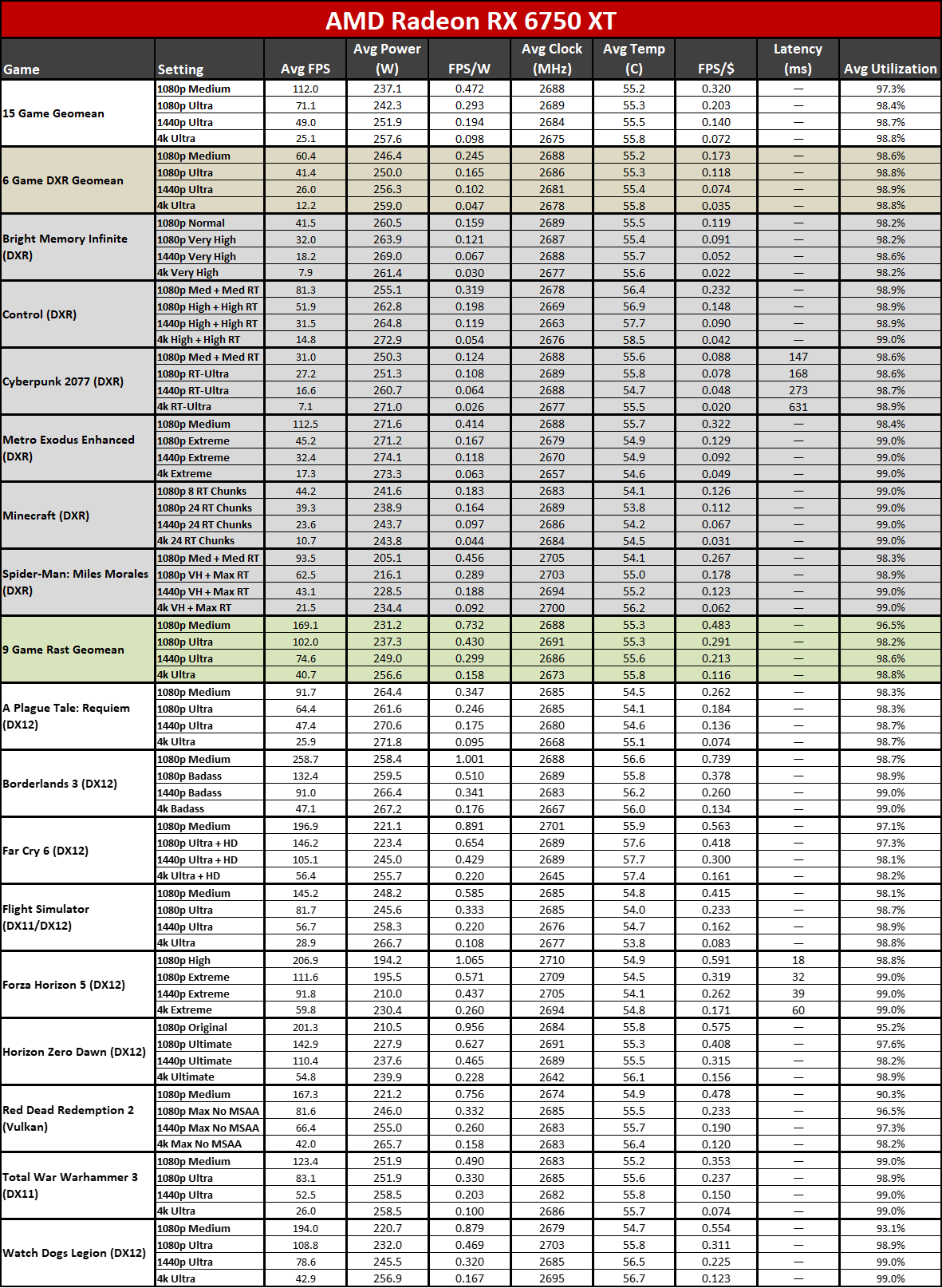
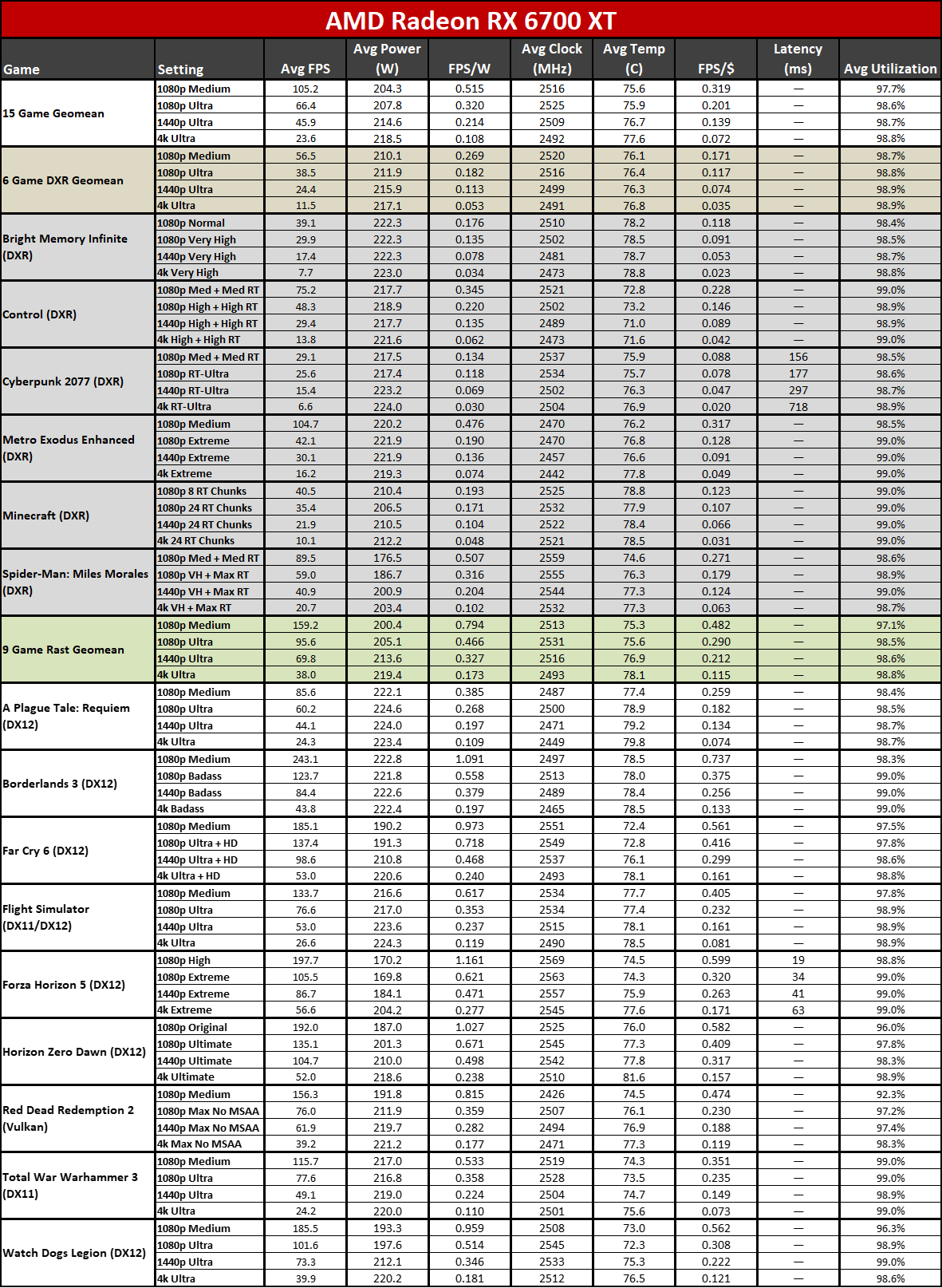
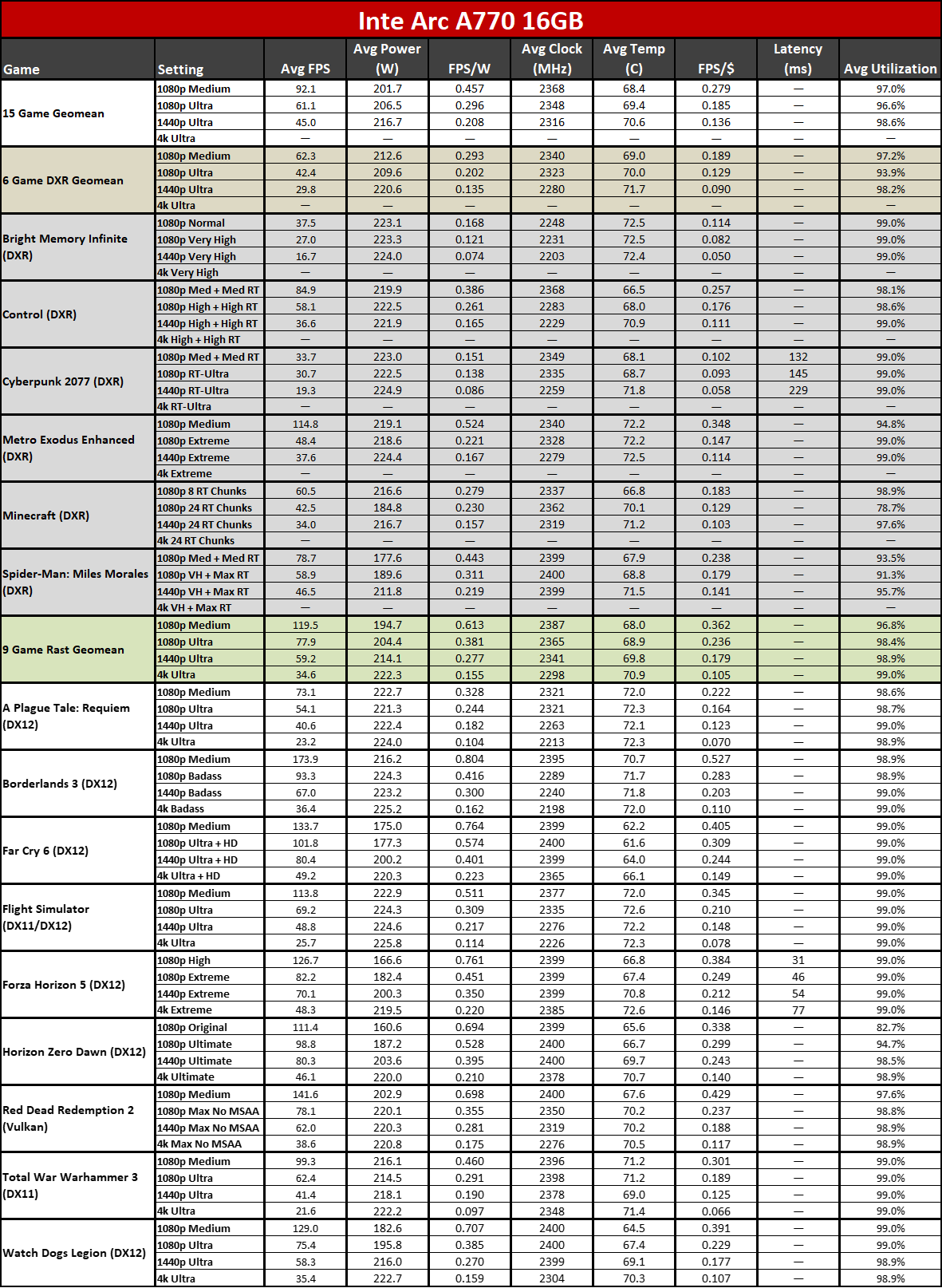
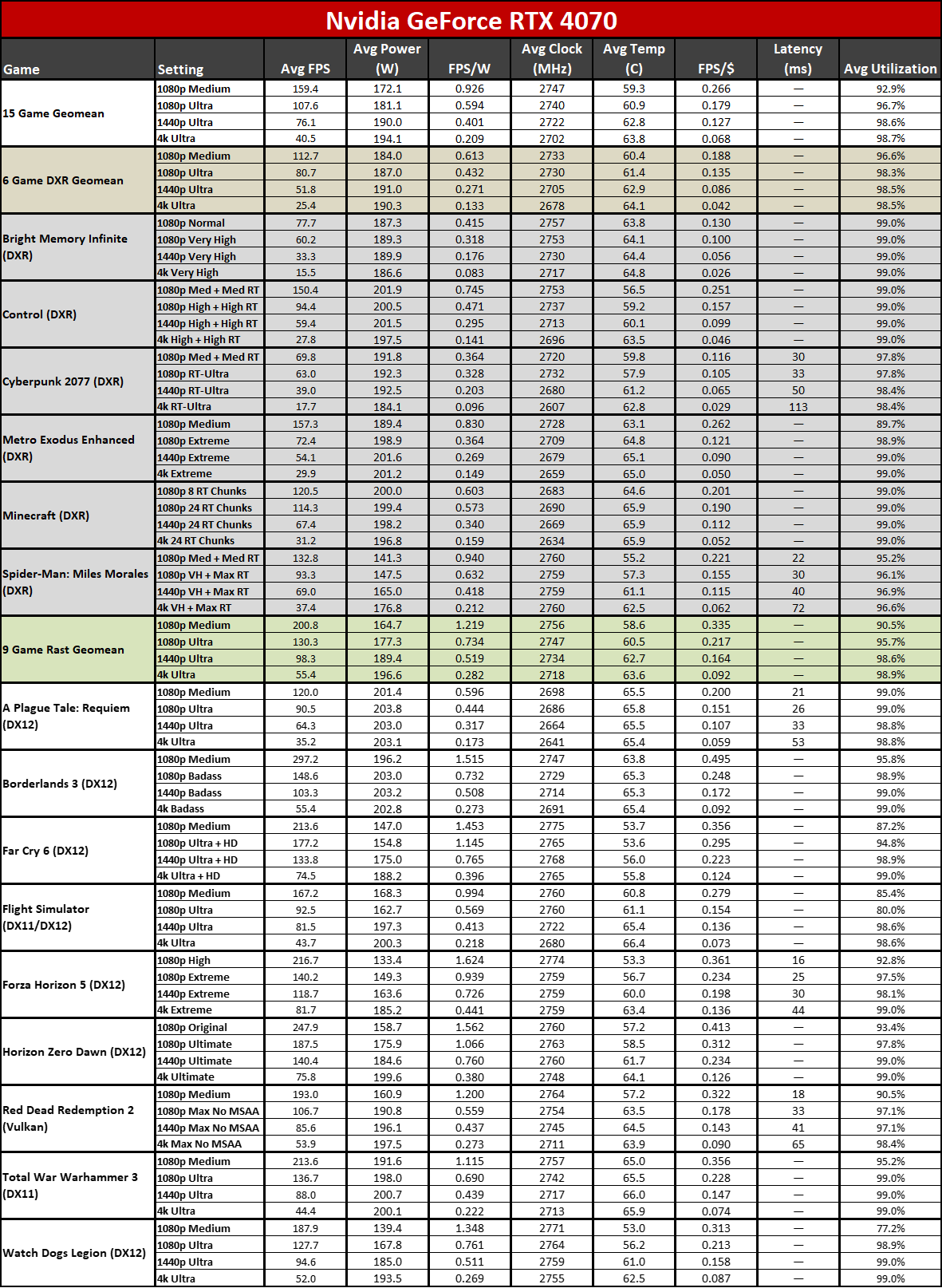
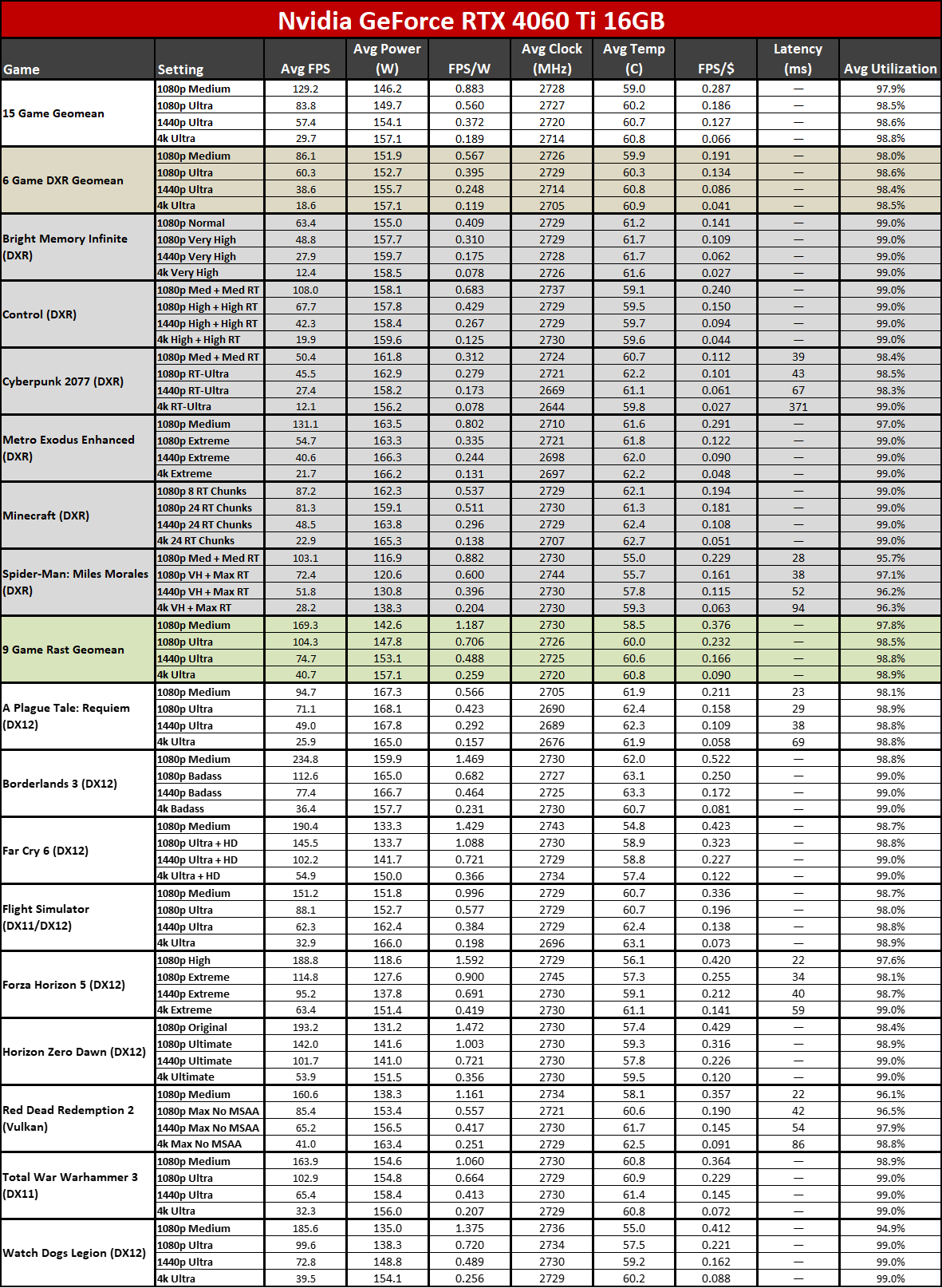
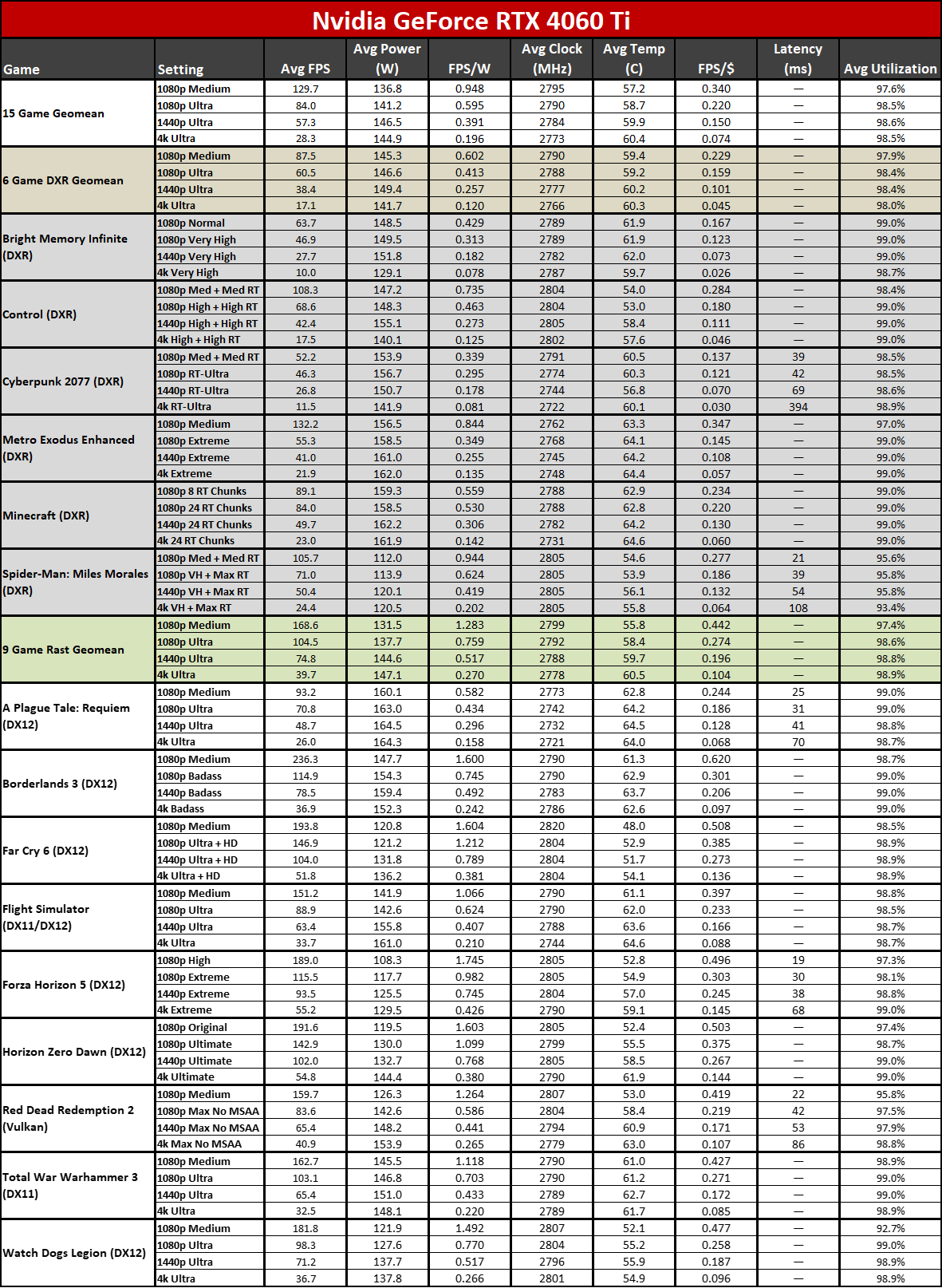
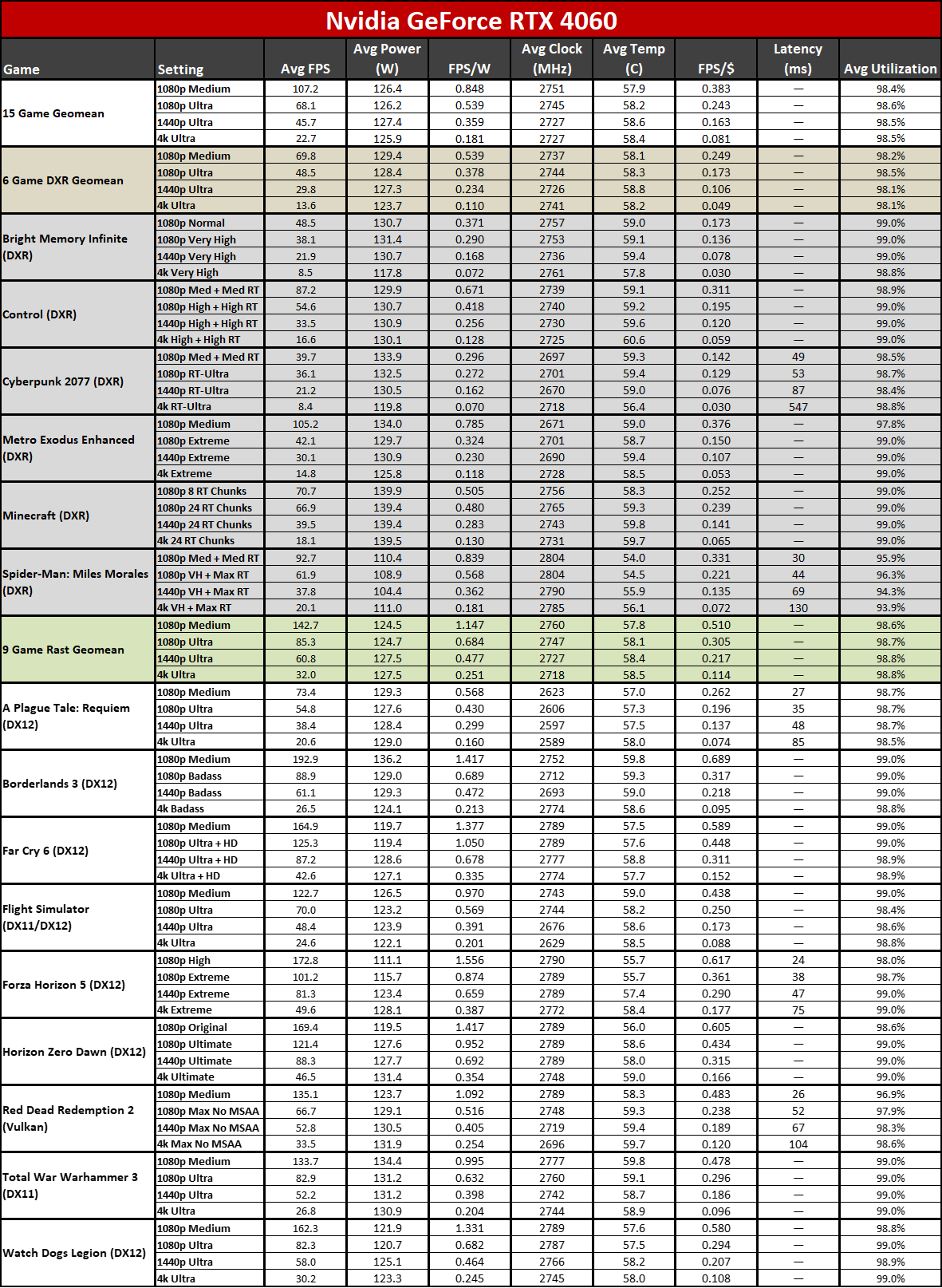
Here's the full rundown of all of our testing, including performance per watt and performance per dollar metrics. The prices are based on the best retail price we can find for a new card, at the time of writing. These values can fluctuate, especially on previous generation cards — the RX 6950 XT, 6900 XT, 6800 XT, and 6800 have all changed by about $20–$30 in the past couple of weeks, with only the 6950 XT having gone up in price.
It's also worth noting that, unofficially, the base price for the RTX 4060 Ti 16GB has dropped to $449. Whether that will be a long-term change and we can expect to see such cards maintain that price level, or if it's just short-term shenanigans ahead of the RX 7800/7700 XT launch, remains to be seen. For now, that means the RTX 4060 Ti 16GB costs as much as the RX 7700 XT, while the 8GB card holds a $50 pricing advantage.
Based on the current retail prices, the best GPU value of the cards we've listed above (at 1440p and in FPS/$) is the RTX 4060, followed by the RTX 4060 Ti. RX 7800 XT ranks third, then the RX 6700 XT, 6750 XT, and finally the RX 7700 XT. The "value" metric may not be the best indicator of ranking, but it's interesting regardless.
As for efficiency, again at 1440p in terms of FPS/W, the RTX 40-series GPUs range from 0.35 to 0.39 FPS/W, while AMD's closest is the RX 7800 XT at 0.28 FPS/W, then the RX 7700 XT at 0.25 FPS/W. The previous generation RX 6000-series parts range from 0.19 to 0.25 FPS/W, so AMD did improve in efficiency, just not as much as Nvidia in this generation.
- MORE: Best Graphics Cards
- MORE: GPU Benchmarks and Hierarchy
- MORE: All Graphics Content
Get Tom's Hardware's best news and in-depth reviews, straight to your inbox.
Current page: Radeon RX 7700 XT: Power, Clocks, Temps, and Noise
Prev Page Radeon RX 7700 XT: Professional Content Creation and AI Performance Next Page Radeon RX 7700 XT: Needs a Price Cut
Jarred Walton is a senior editor at Tom's Hardware focusing on everything GPU. He has been working as a tech journalist since 2004, writing for AnandTech, Maximum PC, and PC Gamer. From the first S3 Virge '3D decelerators' to today's GPUs, Jarred keeps up with all the latest graphics trends and is the one to ask about game performance.
-
cknobman This card will be a winner when the price is reduced to $400.Reply
Between this card and its bigger brother, the 7800XT, Nvidia's 4060 series of cards (and maybe even the 4070) are completely irrelevant now. -
oofdragon Replycknobman said:This card will be a winner when the price is reduced to $400.
Between this card and its bigger brother, the 7800XT, Nvidia's 4060 series of cards (and maybe even the 4070) are completely irrelevant now.
I'd say the 7800XT will be a winner in a year or two when it's discounted at $400. The 7700XT at 12GB is more like.. $300. -
Colif Both cards released make the 4060 TI even more of a joke than it was already.Reply
5TGHvXKkhao
The price difference is bigger in other countries, it makes more sense there.
7800xt in Australia is about $1000
7700xt in Australia is about 860
7800xt selling out fast so 7700xt might be only choice for a few weeks in some places. -
JarredWaltonGPU Reply
Does it, though?Colif said:Both cards released make the 4060 TI even more of a joke than it was already.
The price difference is bigger in other countries, it makes more sense there.
7800xt in Australia is about $1000
7700xt in Australia is about 860
7800xt selling out fast so 7700xt might be only choice for a few weeks in some places.
272
So 20% faster in rasterization, 8–10 percent slower in DXR, uses 60W more power, costs 12.5% more. The 128-bit and 8GB is a concern, sure, but it's absolutely not the end of the world. Turn down settings to high and it's fine, even at 1440p.
7800 XT makes for a bigger gap, and that's definitely the better card of the 4060 Ti/7700 XT/7800 XT class. But the 7700 XT isn't a clear-cut winner in every situation: Higher power, worse RT, worse AI hardware, higher cost. -
P1nky Reply
Can't believe you're actually defending the 4060 Ti, a GPU with just 8GB for a massive $400 price. No wonder you gave the 7700 XT a meh rating.JarredWaltonGPU said:So 20% faster in rasterization, 8–10 percent slower in DXR, uses 60W more power, costs 12.5% more. The 128-bit and 8GB is a concern, sure, but it's absolutely not the end of the world. Turn down settings to high and it's fine, even at 1440p.
7800 XT makes for a bigger gap, and that's definitely the better card of the 4060 Ti/7700 XT/7800 XT class. But the 7700 XT isn't a clear-cut winner in every situation: Higher power, worse RT, worse AI hardware, higher cost.
You must watch HU's investigation of how bad the textures look on just 8GB, even if the framerates are unaffected. There are plenty of games that won't be bottlenecked by 8GB by 30 second benchmark runs. Cards might performs similarly sometimes, but the texture experience and frame drops on on 4060 Ti are a joke on long benchmark runs. -
luissantos ReplyJarredWaltonGPU said:So 20% faster in rasterization, 8–10 percent slower in DXR, uses 60W more power, costs 12.5% more. The 128-bit and 8GB is a concern, sure, but it's absolutely not the end of the world. Turn down settings to high and it's fine, even at 1440p.
7800 XT makes for a bigger gap, and that's definitely the better card of the 4060 Ti/7700 XT/7800 XT class. But the 7700 XT isn't a clear-cut winner in every situation: Higher power, worse RT, worse AI hardware, higher cost.
Your only valid point is power consumption.
DXR performance is mostly irrelevant: neither card is sufficiently capable in that regard. Until DXR comes with a 5-10% penalty in performance it will remain a gimmick. In fact, games that have had a "modern render release" like Quake 2 look far better using said new render than DXR. For CP2077 I'm sure I could find plenty of scenes where I could take a screenshot with RT on and off and trick you into guessing incorrectly. Moreover, UE 5's Lumi produces reasonably similar results with RT on and off, and that engine will have the most coverage of any other in the game market for the years to come.
As for AI, just a few weeks ago AMD announced huge strides in that field as well, but again, that's irrelevant. What percentage of the market is buying a consumer mid-range GPU to focus primarily (or at all) on AI? -
JarredWaltonGPU Reply
The texture stuff is mostly game specific. Some games (Gollum, Star Wars, and basically a lot of Unreal Engine stuff) do a poor job at managing VRAM and so when the game exceeds 8GB, they load minimum res on some surfaces and not others. Then you get "texture popping" and stuttering. It's frankly a bad game engine design. Lots of other games exist that look very good and don't have the same problem, so it's pretty much a matter of coding quality and effort.P1nky said:Can't believe you're actually defending the 4060 Ti, a GPU with just 8GB for a massive $400 price. No wonder you gave the 7700 XT a meh rating.
You must watch HU's investigation of how bad the textures look on just 8GB, even if the framerates are unaffected. There are plenty of games that won't be bottlenecked by 8GB by 30 second benchmark runs. Cards might performs similarly sometimes, but the texture experience and frame drops on on 4060 Ti are a joke on long benchmark runs.
The solution is to turn texture and shadow resolution down a notch, which usually drops VRAM use from <12GB to <8GB and rarely has a noticeable impact on visuals. Except some games (again, UE especially) don't even seem to do this very well. Software optimizations, particularly with low-level APIs (DX12/Vulkan) can easily deliver a 50% boost in performance, sometimes more. It's just a matter of how much effort the developers / publishers want to expend.
I’m not saying 4060 Ti is great. I’m just pointing out that it’s not universally inferior to the 7700 XT / 7800 XT. 192-bit and 12GB or 256-bit and 16GB is inherently a superior configuration to 128-bit and 8GB/16GB. There's no question about that. But VRAM capacity and bandwidth aren't the only factor that matters. -
shady28 Agree this isn't all that impressive, but neither was the 4060 Ti. I bought a 6700XT last year, and after seeing the 4060 Ti I really have no regrets.Reply
This 7700XT doesn't really seem to change any of that. If it were say $399 instead of $450, it might be ok. It's kind of a trade off with the 4060 Ti, generally better on performance (but not always) while losing on gaming power draw, but costs $50 more, which is frankly not good enough for an AMD GPU.
Best deal on your comparison is still the 6700 XT. -
Ilijas Ramic Reply
In my country the price diff is around 140usd 7700xt vs 7800xt. I ordered 7700xt for 680usd while the 7800xt is 820usd. Its almost 3x more price diff what most people pay. Also most people buy from newegg since they are from US. But us EU people are getting a hefty pay up on these card. Heck the newegg price is 450usd for 7700xt while i have to pay 230usd more. I havent upgraded my gpu for like 8 years now. Heck i got r9 380 on release date. And i paid back than msrp US price here wich was shocking 200usd. But after that we got price diffs soo large i just couldnt afford to upgrade.Colif said:Both cards released make the 4060 TI even more of a joke than it was already.
5TGHvXKkhao
The price difference is bigger in other countries, it makes more sense there.
7800xt in Australia is about $1000
7700xt in Australia is about 860
7800xt selling out fast so 7700xt might be only choice for a few weeks in some places.

